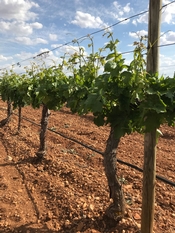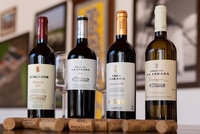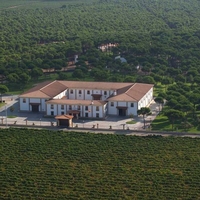 Among the many wonderful things about wine is that so-called “established facts” are only established until somebody comes along with enough energy and ambition to dis-establish them. Regarding the large region of La Mancha, the “established fact” is that if you want fine Spanish wine, look elsewhere. According to the 2nd Edition of The Oxford Companion to Wine, “Traditionally the grapes were picked late in the season and fermented rapidly without temperature control in earthenware tinajas. As a result, Manchegan wine was coarse and alcoholic. Much was distilled or sold in bulk, and most wines were brown and oxidized by the time they reached consumers.”
Among the many wonderful things about wine is that so-called “established facts” are only established until somebody comes along with enough energy and ambition to dis-establish them. Regarding the large region of La Mancha, the “established fact” is that if you want fine Spanish wine, look elsewhere. According to the 2nd Edition of The Oxford Companion to Wine, “Traditionally the grapes were picked late in the season and fermented rapidly without temperature control in earthenware tinajas. As a result, Manchegan wine was coarse and alcoholic. Much was distilled or sold in bulk, and most wines were brown and oxidized by the time they reached consumers.”
 Major changes were afoot prior to the turn of the millennium, but a lot of La Mancha’s grapes still get distilled to make brandy, and the region’s less-than-flattering reputation stalks the wines to this day. That’s not all bad, however, as the very best producers are now making excellent wines that are priced far below what their quality could command from more fashionable regions. Among these “very best producers,” Pago de la Jaraba is my favorite on account of a line of wines that offers something for almost everyone’s taste and budget—with remarkable value at every level.
Major changes were afoot prior to the turn of the millennium, but a lot of La Mancha’s grapes still get distilled to make brandy, and the region’s less-than-flattering reputation stalks the wines to this day. That’s not all bad, however, as the very best producers are now making excellent wines that are priced far below what their quality could command from more fashionable regions. Among these “very best producers,” Pago de la Jaraba is my favorite on account of a line of wines that offers something for almost everyone’s taste and budget—with remarkable value at every level.
The estate produces a very good Pago de la Jaraba Sauvignon Blanc 2020 ($22, 91 Points) that is medium-bodied and admirably complex in flavor despite not being influenced by oak. With fruit flavors spanning the Sauvignon spectrum ranging from melon to citrus, along with good palate weight but still a lot of refreshment value. An exceptionally versatile white, this will pair beautifully with almost anything you’ll place on your summer dining table, and it also performs very well as a stand-alone sipper.
The current release reds are all reviewed below, beginning with one of the most interesting wines you could find from anywhere in the world for twelve bucks and running down to a truly great wine for less than $30. Imported by Aurelio Cabestrero through his company, “Grapes of Spain,” these are reasonably available in many US states, and they will banish once and for all any lingering notions that La Mancha can’t make terrific wines:
Viña Jaraba (La Mancha, Spain) Consecha 2019 ($12): Like most of the wines from this impressive estate, this is predominantly comprised of Tempranillo (80%) with 10% each Cabernet Sauvignon and Merlot. Red berry fruit aromas and flavors are quite exuberant but not grapey or obvious at all, with no evidence of overt oak but some clear benefit from oxygen interchange gained from 4 months in oak barrels. In terms of weight and food pairing suitability, this is comparable to relatively inexpensive Pinot from California or Toscana Rosso IGT wines, but much, much better than most of the wines in either of those categories at this asking price of $12. It is much more savory and interesting than its CA Pinot competitors, and seems much less manipulated than the Tuscan competition priced in the low teens. Test this for yourself against almost anything in either category and you’ll see what I mean. 89
Viña Jaraba (La Mancha, Spain) Crianza 2017 ($14): This is among the most complex wines I’ve tasted in this below-$15 price range I have tasted for quite some time, and though I really admire the 2019 Consecha release from this producer, you’d be well advised to pay $2 more for this. (However, any particular retailer is likely to have only one or the other in inventory, so if you see either of them, just grab, pay and run…gratefully.) This shows just enough oak influence to provide some spice notes and firm up the finish with a little grip, yet the wine is definitely not overtly oaky (as the legal term “Crianza” might make you fear, based on the style of many inexpensive Rioja wines). The eight-month span in oak barrels actually seems to have had more influence due to oxygen interchange than outright wood flavoring, which suits me just fine. Though there’s less annoying oak in this than comparably priced Rioja, that’s partly because the wine has more body and fruit, thanks to a warmer climate and 10% each of Merlot and Cabernet Sauvignon. Excellent period, and amazing for the price. 91
Viña Jaraba (La Mancha, Spain) Reserva 2016 ($16): Of all the wines in the current set of releases from this excellent, high-value producer, this one shows the character of its growing season most clearly. Elegant and complex and refined like so many 2016 wines (not only from Spain, but also Italy and France among others), this shows terrific class and complexity for a $16 wine. It is no richer than the 2017 Crianza from this house, so don’t buy it for “punch.” However, it shows an extremely high ratio of aroma and flavor to its weight, which is precisely the characteristic that makes for magic in wines from, say, Barbaresco or Burgundy. The key difference here is that this costs less than 1/3 of what you’d pay for a wine of comparable quality from either of those regions. Enough said. When I first opened the five current releases from Jaraba, this was actually my favorite, though the Pago de la Jaraba surpassed it when fully aerated. I note this only to let you know that this is ready to enjoy now, and wow…is it ever enjoyable. 93
Viña Jaraba (La Mancha, Spain) “Selección Especial 2018 ($20): Among the current releases from this exemplary producer, this stands with the top-of-the-line 2018 Pago de la Jaraba as wines made for the cellar rather than current consumption, though the remarkably reasonable price of $20 for this could lead you to believe otherwise. It shows notably more weight than the 2016 Reserva and though the wood is still reserved, this is the more taut and uncoiled of the two. It incorporates 20% Cabernet Sauvignon and 10% Merlot, like the 2016 Reserva, but they are more evident in this wine, whereas the silky, subtle 2016 Reserva could easily pass for a 100% Tempranillo wine. Our back-of-the-house WRO software won’t allow me to give this a score of 92+ to account for the wine’s ability to develop positively from time in bottle, but that potential is evident, so add a plus yourself and keep an eye peeled for this great value when scrutinizing for retail availability. 92

1
